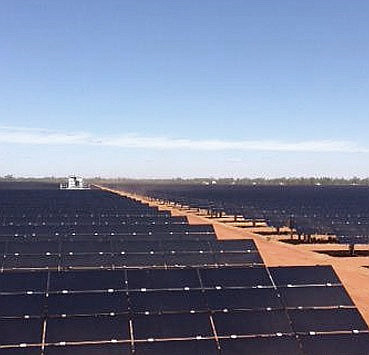Green subsidies keep powering
 AGL has over $230 million in direct grants to fund its flagship solar generators, amid bickering over how to fund such works in the future.
AGL has over $230 million in direct grants to fund its flagship solar generators, amid bickering over how to fund such works in the future.
The size of renewable energy subsidies has become a key question in the government’s debate on whether to embrace a clean energy target.
Opponents want AGL and other firms to prove that wind and solar schemes can work without taxpayer handouts.
The Federal Government is yet to decide on a clean energy target, but has spoken against large subsidies, focusing instead on cheaper power supplies like coal and gas.
AGL has two solar farms in western NSW which have secured more long-term investment thanks to the continuation of the renewable subsidy until 2030.
AGL solar projects at Nyngan and Broken Hill received $166.7 million in direct grants from the Australian Renewable Energy Agency and another $64.9 million from the NSW government.
They also qualify for credits under the renewable energy target.
AGL sold the two projects to its Powering Australian Renewables Fund last November, making no cash profit in the sale.
The company owns 20 per cent of the fund, with Queensland Investment Corporation clients including the Future Fund holding the other 80 per cent.
Investors say stopping the taxpayer assistance for renewables would lead to an investment freeze that will intensify looming energy shortages.
Former resources minister Matt Canavan says the subsidy going to AGL shows renewables are not as useful as coal.
“AGL keeps telling everybody that renewables no longer need a subsidy — well, if that’s the case, why do we need a clean energy target?” Senator Canavan said.
Reports say the government is looking at a “capacity pricing” subsidy structure to make it easier for coal and gas to meet the Prime Minister’s stated aim of improving the ability to “dispatch” power at short notice.
AGL chief financial officer Brett Redman has told News Corp reporters that the subsidies for the solar farms will shrink as the value of renewable energy certificates declines.
Mr Redman also said the government’s looming decision on a clean energy target does not make a new coal-fired power station viable.
“The economics are now somewhat overwhelming — the world of electricity generation is heading down the renewables path,” Mr Redman said.
“Even without the impact of carbon-emissions policies, we would absolutely be heading down the path of building more renewables. Coal-fired power will not be built in that world.”
Mr Redman said the two heavily-subsidised NSW projects were built to demonstrate large-scale solar at a time when its cost was much higher than it is today.
He said “we’d build a wind farm in every backyard” if the spot price of certificates stayed at the level they are today, but that the values would fall in the early 2020s.







 Print
Print